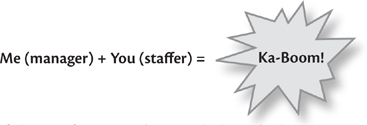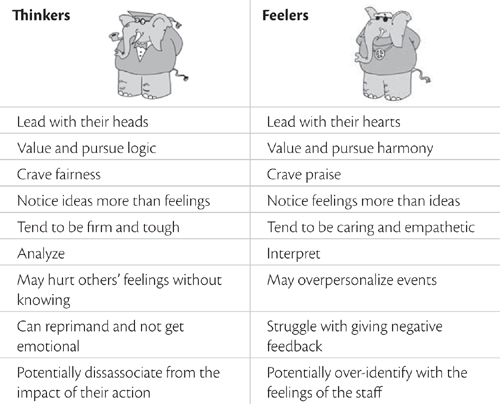CHAPTER TWO
Who Are You?
But enough about me, let’s talk about you… What do you think of me?
—C. C. Bloom (Bette Midler’s character in Beaches, screenplay by Mary Agnes Donoghue)
There once was a manager named You
Who had no idea what to do
Until You took this here quiz
Took control of your biz
Into a leadership star You grew.
Why don’t managers just read a well-respected tome on Management (there are several options available with that very title!), do as instructed, and move on with their lives?
Because there is not one correct way to do things. There are endless variables that factor into how to manage most effectively, and they differ with every single person on your team.
If that isn’t an exhausting thought, I don’t know what is.
People come equipped with this pesky item commonly referred to as a Personality. Personalities are infuriating. Particularly when yours differs from mine. Once we get to know each other, yours can be intolerable even when it is quite similar to mine, just to keep things jumping. In fact, I can hardly stand my own half the time.
When are those robot people predicted back in the 1970s going to emerge?
As an MBA, I am trained to resort to Useful Charts and Numbers to make a point. Here’s mine:

Part of the confusion and general chaos lurking just a millimeter behind the surface of any basic, seemingly well-functioning organization is due to cataclysmic clashes of personality.
There are many aspects to personality. Thinker–Feeler is one of four dimensions highlighted in the Myers–Briggs Type Indicator and is linked to how we make decisions, communicate, and manage. To satisfy the curiosity of the academics out there, MBTI has roots in the teachings of Carl Jung. Think of Jung as the grandfather of personality theory. Maybe great-grandfather by now.
Managing for People Who Hate Managing (MFPWHM. Such a catchy acronym… so memorable!) will guide you through the Thinker–Feeler continuum, a sublime cavern of our inner worlds. You will learn versatile techniques to be a stellar manager by being yourself. You on board?
The good news keeps on coming. The techniques introduced are transferable to virtually all management situations. I don’t even know why I said “virtually.” I can’t think of any exceptions. With all those lawyers out there, you can’t be too careful. If you discover an exception, e-mail my people. I will claim it didn’t make it to my desk.
Let’s start with the basic premise everybody thinks and everybody feels. Well, nearly everyone, but that’s an issue we’ll deal with later. For our current purposes, this premise works.
Managers are in the position to make gobs of decisions daily. Quickly. How you make decisions is a key aspect of how you manage. Notice I didn’t say what decisions you make. We’re a layer deeper than that here… digging down into the way you make decisions.
Although thinkers are (for the most part) capable of actual feelings, and feelers (despite misconceptions) really do think.
Thinkers lead with their heads; feelers lead with their hearts.
From this page forward, when we say “thinker” (or just T), that is shorthand for “people who primarily think to make decisions.” And when we say “feeler” (or just F), what we’re really saying is “people who primarily feel to make decisions.”
This chapter also discusses the continuum of thinkers and feelers, because there are gradations, levels, degrees, if you will.
The Royal Rule
It’s insane to assert there are hard-and-fast rules for being the best of all managers. A real sickness. Okay, so there is one rule. And I get to set it. Cue fanfare!
The only indisputable, irrefutable, inarguable, brilliant, life-changing rule, doctrine, law, MANDATORY realize-it-or-regret-it foundation of being the best possible manager ever is:
… be you.

Piece of cake, no? Perhaps a complex, homemade, multistep, carefully executed, and years-to-develop cake recipe. Maybe that.
There are a startling number of steps and skills involved in being yourself. Sigh. Is nothing easy in this world? My sentiments precisely.
Luckily, I’ve thrown away years of a potentially lighthearted, carefree life to benefit you.
While you were doing… whatever… I’ve had my nose to the grindstone, focused almost exclusively on the nuances of personality. Sure, I come up for air and regular feedings, but that’s about it. And now, with minimal exertion on your part, I am handing my findings over for your consumption and daily use. Start thinking about a meaningful holiday gift now; it’s never too early.
The path toward being you is knowing you. The upcoming assessment pinpoints a key aspect of your personality, helping you harness the best you have to offer as a manager.
The Thinker–Feeler continuum (we will also reference it as T/F) is a prime indicator of how one manages in a work environment. This preference affects both behavior and internal processing of experiences.
You’ll learn about different personality types—not just your own but also others, because you are undoubtedly managing plenty of lunatics from “the other side” (that is, whichever side is not your own). Understanding people’s behavior at work will reduce your frustration and increase your efficiency. This frees up your time and energy.
In case you are wondering, personality temperaments are innate. That means your preference, your essence, your natural style, is part of your core. This does not limit you in any way. You are in charge of your abilities—and can teach yourself whatever skills you deem important. Plenty of people become so adept at modeling behaviors from an opposite temperament that the casual observer would believe it’s their natural style. This is not being artificial; it is being flexible. Lots more on this ahead.
Now, tighten that safety belt across your lap—we’re about to reveal the Real You beneath that suave exterior. It’s high time.
 SELF-ASSESSMENT INSTRUCTIONS
SELF-ASSESSMENT INSTRUCTIONS
Each numbered item offers two options to complete a sentence. Assign three points between these two options based on your natural preferences and point of view. Point distributions are 3 and 0, or 2 and 1, no half points. If you agree entirely with A and not at all with B, assign A = 3 and B = 0. If you relate somewhat with A yet more with B, assign A = 1 and B = 2. Respond based on your natural temperament, not learned behavior or what you think is “right.”


Self-Assessment Scorecard
(Be alert! Columns include a mix of A and B!)


32–36: Strong preference
28–31: Clear preference
22–27: Moderate preference
19–21: Slight preference
The Spectrum
All personality dimensions exist along a continuum. There are not two paper-cutout versions of personalities, pure thinkers (T) or pure feelers (F). If only! Imagine how much easier staff meetings would be—particularly if the two camps held separate meetings.
There are a slew of styles. T/F is one of many different aspects of our complex dispositions. Other personality dimensions influence our interactions as well. For example, introversion and extroversion also play into management style, as addressed in chapter 9. However, this book highlights T/F because of its uniquely strong, direct impact on how we manage.
To keep things lively, Ts and Fs come equipped with nuances. Along the way, you’ll meet Ts and Fs with strong, clear, moderate, or slight preferences. What I call an off-the-chart T (preference rating 32–36) is notably different from a slight T (preference rating 19–21). Nevertheless, we gain tremendous insight even by focusing broadly on the distinguishing traits of Ts and Fs.
What if you are in the middle? Let’s say you scored a dead heat of 18/18 on the assessment—or real close to it. Do you need immediate treatment? No. Scoring in or near the middle of the continuum does not correlate with being flaky, wishy-washy, or confused. Instead, your results indicate you have a solid dose of both thinker and feeler attributes inside of you. You are good to go.
Scoring a tie or slight preference indicates you can understand, relate to, and manage a range of personalities with less effort than those of us entrenched in the distant ends of the spectrum. Looking in my crystal ball, I’d say you also come equipped with a natural ability to establish rapport, build coalitions, and mediate conflict. Others can learn these skills, too. It just comes more easily for you. At the same time, it is certainly useful to gain a solid understanding of those who exhibit stronger preferences than yourself.
While keeping in mind variations among Ts and Fs, we will pay the most attention to the outer ends of the continuum. This is done intentionally, to clarify differences. We need to understand what distinguishes thinker and feeler management styles to become attuned to more subtle distinctions.
Feelers & Thinkers
There’s a reason for everything, even for titling this section “Feelers & Thinkers” rather than “Thinkers & Feelers”: the Fs would read into it if they were listed second and the Ts couldn’t care less. This is an example of how understanding different types sensitizes you to their needs and preferences.
If that’s not something to look forward to, frankly, I don’t know what is.
When introducing the T/F assessment, I’m often privy to protest. Thinking and feeling are loaded descriptors, and no one exists in an all-or-nothing situation.
This might be a shocker; prepare yourself. The T/F dimension is not linked to intellect. Or emotion. It also is not related to decisiveness or even the quality or outcomes of decisions. It has nothing to do with creativity. So what is T/F all about?
Your placement on the T/F continuum indicates whether you primarily lead with your head or with your heart. When deciding what to do in a situation, Ts consider principles and are typically drawn to the most rational choice, whereas Fs consider values and are often drawn to the most sensitive choice.
Peruse this handy, portable summary sheet, created for your exclusive use:

You can’t make everyone happy, a fact that makes Ts shrug and Fs sob in despair (at least internally). However, you can assess a situation and notice your natural response. Take a reality check by discussing and calibrating your reactions with others. Consider the best overall outcome and adjust to fit the challenge.
And yes, thinkers feel and feelers think. Everyone does both. It’s all a matter of degrees.
Do people change? Yes. Do they flip from T to F and back again? Sometimes. It depends. Most of us stay pretty consistent in our temperament. If you exhibit only a slight preference for T over F or vice versa, it would not be extraordinary for you to sway back and forth daily.
Communication: Conflicts or Connections?
What is managing all about? When polled, Ts and Fs reveal quite different perceptions. Here’s a beauty of an excerpt from a hard core T.
All managing is about conflict—conflict with yourself, conflict with others, conflict with processes and procedures, conflict with data and projections, and so on. But mainly you hate managing because your performance, success, and job satisfaction is dependent on others. You can be a friggin’ genius, and if you were an engineer, you’d be the talk of the company. But if you’re a genius who happens to be a lousy manager, you’re just a lousy manager. You hate managing because you have to depend on others and others have to depend on you and all of the complexities inherent to such a situation drive you nuts.

I could survive a week on that quote alone… I am easily amused.
And how did an F respond to the same question, What is managing all about?
When you get down to it, managing is about creating connections and establishing a safe, respectful environment of open sharing and communication. Managing is connecting. The hardest part while supervising is to having to put my empathetic feelings aside and focus on behaviors. The part I hate is dealing with negative issues when an employee is not doing his job well.

What is so T and then so F about these two responses? Let’s take a closer look.
The T uses the word conflict with ease, while the same word is laden with negativity and strife for an F. The T writes with customary authority, throwing around practical, objective measurements of professional success. He also doesn’t mince words: There is no sugar-coating of opinions.
The F is almost apologetic for his opinion (both examples are from men). Mr. F uses “feeling” words—create, safe, respectful, feelings. The T speaks with objectivity—process, procedure, data, performance, complexities.
Glance through these responses again, noticing the cues tossed at us with the carefree ease and bounty of rice at a wedding. Don’t worry; I won’t force you to backtrack, losing ground in your success rate of pages clocked in the book. Reprinted and bolded here for your careful inspection.
THINKER RESPONSE DECODED
All managing is about conflict—conflict with yourself, conflict with others, conflict with processes and procedures, conflict with data and projections, etc. But mainly you hate managing because your performance, success, and job satisfaction is dependent on others. You can be a friggin’ genius, and if you were an engineer, you’d be the talk of the company. But if you’re a genius who happens to be a lousy manager, you’re just a lousy manager. You hate managing because you have to depend on others and others have to depend on you and all of the complexities inherent to such a situation drive you nuts.
FEELER RESPONSE DEMYSTIFIED
When you get down to it, managing is about creating connections and establishing a safe, respectful environment of open sharing and communication. Managing is connecting. The hardest part while supervising is to have to put my empathetic feelings aside and focus on behaviors. The part I hate is dealing with negative issues when an employee is not doing his job well.
Once you get used to spotting telltale signs, it’s a sport. Not an acceptable substitute for good old-fashioned cardio, though.
Comparisons for Your Consideration

That last item on the list reminds me of a high-ranking T in commercial real estate. He manages a demanding portfolio in a high-pressure environment. He sets collective goals, supports his staff, and is committed to his department. Consequently, he has a loyal, hard-working staff. He coined his own word: wantitude. He defines it as a merger of attitude and passion and says it’s what he demands of himself and everyone around him. I asked him how he handles giving negative feedback. He smiled amicably, shrugged, and explained, “It’s not hard for me to have those conversations. I’m not the one under-performing.” His authentic style makes his T style of management work just fine.
Certain fields attract a higher-than-average ratio of Ts or Fs. For example, many nonprofits I work with have an abundance of Fs, whereas the financial industry often attracts a high percentage of Ts. Within organizations, the accounting department is likely to be heavily T and human resources primarily F.
At the same time, you might be surprised to discover a T surrounded by Fs in an earnest grassroots association or an F among Ts working in construction. When someone has a passion for her work, she can flex her style in any industry.
Likewise, Ts and Fs can pursue identical careers for divergent reasons. For example, we might assume high school English teachers are Fs who want to create a nurturing, warm environment full of positive reinforcement. However, I worked with a T high school English teacher. He taught the students structure and organization while preparing them with strategies for future challenges. Students said he was tougher on them than any previous teacher. He won teaching awards from his students year after year.
Full Disclosure. Well, Partial.
I’ll come clean. I’m a… how to put this? Blazing feeler. Believe you me, it is not an easy way to live! Everything swirls round in feelers’ heads endlessly as we psychoanalyze what was said to us, what we did or didn’t reply, and how we feel about it.
However, I take it as a marvelous compliment that I am often mistaken for a thinker on the job. This doesn’t mean thinkers are superior. If I was a strong thinker and the reverse happened I would feel equally pleased. Um, I mean, I would think it was evidence of my strength. The upshot is that managers of either temperament can learn to effectively flex their style so as to be indiscernible from the real deal.
Being flexible in how you communicate does not change your core. It does not mean being phony. Quite the opposite. Being a flexible manager requires strong self-knowledge, astute observation skills, and application of your innate strengths.
So I am a feeler who can kick into thinker mode as needed. This is only partial disclosure, because I also happen to be an introvert (see Chapter 9). So, in the end, I won’t disclose a whole heck of a lot.
You’ve got to take what you can get.


